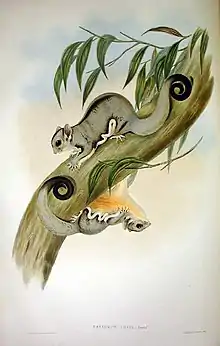| Savanna glider | |
|---|---|
 | |
| Illustration by John Gould | |
| Scientific classification | |
| Domain: | Eukaryota |
| Kingdom: | Animalia |
| Phylum: | Chordata |
| Class: | Mammalia |
| Infraclass: | Marsupialia |
| Order: | Diprotodontia |
| Family: | Petauridae |
| Genus: | Petaurus |
| Species: | P. ariel |
| Binomial name | |
| Petaurus ariel (Gould, 1842) | |
The savanna glider (Petaurus ariel) is a species of arboreal gliding possum in the genus Petaurus.[1]
Taxonomy
It was long considered a subspecies of the sugar glider (P. breviceps), but a 2020 study split P. breviceps into 3 distinct species, with P. ariel being found to represent one of these distinct species.[2][3]
Names
The Bininj of western Arnhem Land, Australia call this animal lambalk in their Kunwinjku language.[4][5]
Description
The species somewhat resembles a small squirrel glider (P. norfolcensis) with a pointed nose. It displays substantial body size variation throughout its range; in the northern, more coastal portions, it is small enough to be considered the smallest of all Australian Petaurus. However, in the arid inland parts of its range to the south, it can grow to be twice as large.[2]
Distribution
The species lives in the wooded savannas of northern Australia. It ranges from northwestern Queensland west through the Northern Territory (including most of the Cobourg Peninsula) to northern Western Australia.[2][6]
Reproduction
In Arnhem Land, breeding is not seasonally restricted and young may be born throughout the year.[7]
Threats
The species is threatened by heavy declines that have been reported to have affected many other small, tree-dwelling mammal species in northern Australia. One study found that the species has undergone a 35% range reduction over the past 3 decades, and is disappearing from inland areas. These declines are thought to be linked to feral cats, changed fire regimes, and feral herbivores.[6] Another study of the Northern Territory populations found a 32% reduction in the species’ extent of occurrence and a 42% reduction in the breadth of occupied environmental space, with a significant contraction towards areas of lower fire frequency.[8]
References
- ↑ "Explore the Database". www.mammaldiversity.org. Retrieved 2021-06-20.
- 1 2 3 Cremona, Teigan; Baker, Andrew M; Cooper, Steven J B; Montague-Drake, Rebecca; Stobo-Wilson, Alyson M; Carthew, Susan M (2020-07-13). "Integrative taxonomic investigation of Petaurus breviceps (Marsupialia: Petauridae) reveals three distinct species". Zoological Journal of the Linnean Society. 191 (2): 503–527. doi:10.1093/zoolinnean/zlaa060. ISSN 0024-4082.
- ↑ "Two New Cryptic Species of Australian Sugar Gliders Discovered | Biology | Sci-News.com". Breaking Science News | Sci-News.com. Retrieved 2021-06-20.
- ↑ Garde, Murray. "lambalk". Bininj Kunwok Online Dictionary. Bininj Kunwok Regional Language Centre. Retrieved 30 Oct 2021.
- ↑ Goodfellow, D. (1993). Fauna of Kakadu and the Top End. Wakefield Press. p. 26. ISBN 1862543062.
- 1 2 Stobo-Wilson, Alyson; Baker, Andrew; Cooper, Steve; Carthew, Sue; Cremona, Teigan. "A rare discovery: we found the sugar glider is actually three species, but one is disappearing fast". The Conversation. Retrieved 2021-06-20.
- ↑ Smith, Meredith J. (13 June 1973). "Petaurus breviceps". Mammalian Species (30): 1–5. doi:10.2307/3503785. JSTOR 3503785. S2CID 254011903.
- ↑ von Takach, Brenton; Scheele, Ben C.; Moore, Harry; Murphy, Brett P.; Banks, Sam C. (2020). "Patterns of niche contraction identify vital refuge areas for declining mammals". Diversity and Distributions. 26 (11): 1467–1482. doi:10.1111/ddi.13145. hdl:1885/286535. ISSN 1366-9516.